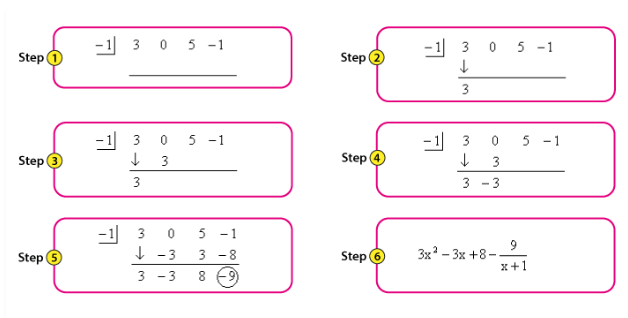How to Divide Polynomials Using Synthetic Division?
When a polynomial has to be divided by a linear factor, the synthetic division is the shortest method. In this article, let's familiarize ourselves with dividing polynomials using synthetic division.

In mathematics, there are two different ways to divide polynomials. One is the long division method. Another method is synthetic division. Between the two methods, the shortcut method for dividing polynomials is the synthetic division method.
Related Topics
A step-by-step guide to dividing polynomials by using synthetic division
Synthetic division is a method used to perform the division operation on polynomials when the divisor is a linear factor. One of the advantages of using this method over the traditional long method is that the synthetic division allows the person to calculate variables without writing them while doing polynomial division, which also makes it easier than the long method.
Synthetic division of polynomials definition
When we divide a polynomial \(p(x)\) by a linear factor \((x – a)\) (which is a polynomial of degree \(1\)), \(Q(x)\) is the quotient polynomial and \(R\) is the remainder.
\(\color{blue}{\frac{p(x)}{q(x)} = \frac{p(x)}{(x- a)} = Quotient + (\frac{Remainder}{(x – a)})}\)
\(\color{blue}{\frac{p(x)}{(x – a)} = Q(x) + (\frac{R}{(x – a)})}\)
We use synthetic division to evaluate polynomials by the remainder theorem, wherein we evaluate the value of \(p(x)\) at \(a\) while dividing \((\frac{p(x)}{(x – a)})\). That is, to find if \(a\) is the factor of the polynomial \(p(x)\), use the synthetic division to find the remainder quickly.
Synthetic division method
The following steps are taken when performing synthetic division and finding the quotient and remainder.
- Check if the polynomial is in the standard form.
- Write the coefficients in the dividend’s place and write the zero of the linear factor in the divisor’s place.
- Bring the first coefficient down.
- Multiply it with the divisor and write it below the next coefficient.
- Add them and write the value below.
- Repeat the previous \(2\) steps until you reach the last term.
- Separate the last term thus obtained which is the remainder.
- Now group the coefficients with the variables to get the quotient.
Note that the resultant polynomial is of one order less than the dividend polynomial.
Dividing Polynomials by Using Synthetic Division – Example 1:
Solve by using the synthetic division method. \(\frac{3x^3+5x-1}{x+1}\)

Exercises for Dividing Polynomials by Using Synthetic Division
Perform synthetic division to find the quotient of the following expression.
- \(\color{blue}{\frac{4x^3-8x^2-x+5}{2x-1}}\)
- \(\color{blue}{\frac{x^3-5x^2+3x+7}{x-3}}\)
- \(\color{blue}{\frac{8x^3+12x^2-2x}{4x^2-1}}\)

- \(\color{blue}{2x^2-3x-2+\frac{3}{2x-1}}\)
- \(\color{blue}{x^2-2x-3-\frac{2}{x-3}}\)
- \(\color{blue}{2x+3+\frac{3}{4x^2-1}}\)
Related to This Article
More math articles
- How to Understand Random Sampling and Variation in Samples?
- How to Use Partial Products to Multiply One-Digit Numbers By Multi-digit Numbers
- How to Compare Fractions?
- How to Solve Arithmetic Series
- Top 10 Tips You MUST Know to Retake the ACCUPLACER Math
- Full-Length 6th Grade IAR Math Practice Test-Answers and Explanations
- 5th Grade MEAP Math Worksheets: FREE & Printable
- How to Decod Decimal Numbers: Dive into Place Values
- 3rd Grade Georgia Milestones Assessment System Math FREE Sample Practice Questions
- Best Calculator For 11th Grade Students


















What people say about "How to Divide Polynomials Using Synthetic Division? - Effortless Math: We Help Students Learn to LOVE Mathematics"?
No one replied yet.